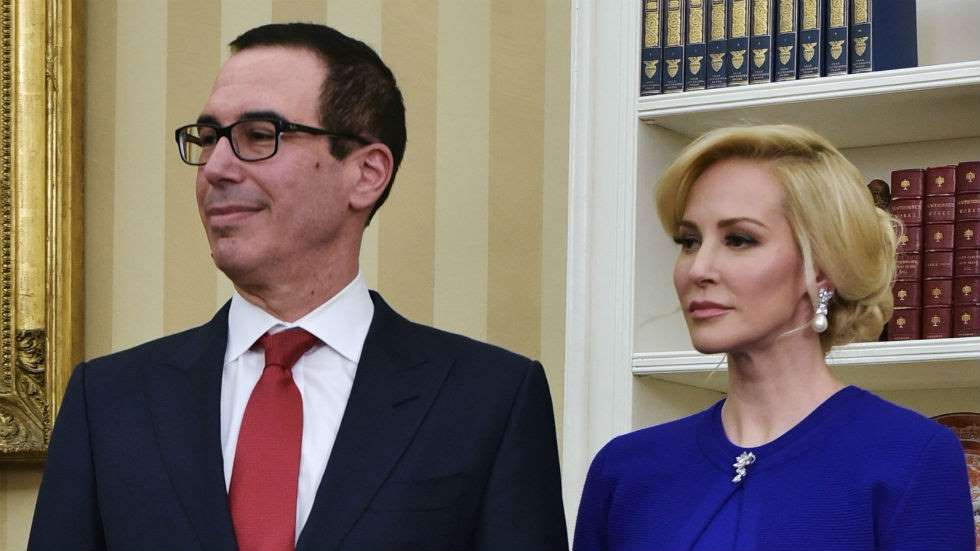April 24, 2017
The White House sought Monday to calm a jittery Washington ahead of a showdown with Congress over spending, and President Trump softened his demand that a deal to keep the federal government open include money to begin construction on his long-promised border wall.

April 24, 2017
The White House sought Monday to calm a jittery Washington ahead of a showdown with Congress over spending, and President Trump softened his demand that a deal to keep the federal government open include money to begin construction on his long-promised border wall.

Treasury Secretary Steven Mnuchin answers questions during the daily press briefing at the White House as press secretary Sean Spicer looks on. “The president is working hard to keep the government open,” Mnuchin said.
Despite one-party control at both ends of Pennsylvania Avenue, the brinkmanship that came to define spending battles in the Obama years has tumbled into the Trump era, as have the factional divisions over strategy and priorities that have gripped the GOP for a decade.
But with a Friday deadline looming to pass a new spending bill, the Trump administration projected confidence that a shutdown would be avoided. In the face of fierce Democratic opposition to fund the wall’s construction, White House officials signaled Monday that the president may be open to an agreement that includes money for border security if not specifically for a wall, with an emphasis on technology and border agents rather than a structure.
Trump showed even more flexibility Monday afternoon, telling conservative journalists in a private meeting that he was open to delaying funding for wall construction until September, a White House official confirmed.
“The president is working hard to keep the government open,” Treasury Secretary Steven Mnuchin told reporters Monday. White House press secretary Sean Spicer said he was “very confident” that an agreement would be reached by Friday, but he pointedly said he could not “guarantee” that a government closure would be averted.
At issue is whether the spending measure will explicitly allocate funds toward building a wall along the U.S.-Mexico border — a campaign promise that was a rallying cry for Trump’s base and one on which he is eager to demonstrate progress by Saturday, his 100th day in office.
Democrats, meanwhile, gave the White House an opening, saying they would agree to some new money for border security — so long as it did not go toward the creation of a wall, something House Minority Leader Nancy Pelosi (D-Calif.) has called “immoral.”
In a speech on the Senate floor, Minority Leader Charles E. Schumer (D-N.Y.) blasted the idea of a wall while suggesting that a combination of smart technology and law enforcement, including the use of drones, would be “a much more effective way to secure the border” without hitting an impasse in Congress.
Republicans were working to define Trump’s campaign promise down, arguing that any form of border security would fulfill it.
“There will never be a 2,200-mile wall built, period,” said Sen. Lindsey O. Graham (R-S.C.), a supporter of immigration reform who challenged Trump in the 2016 primaries. “I think it’s become symbolic of better border security. It’s a code word for better border security. If you make it about actually building a 2,200-mile wall, that’s a bridge too far — but I’m mixing my metaphors.”
Sen. Rob Portman (R-Ohio), a key appropriator and member of Senate leadership, said that “there could be a wall in some places and technology in other places,” implying that there would not be funding for the wall sketched out in campaign rhetoric. “I think you’re going to get a down payment on border security generally,” he said.
Trump has asked Congress for $1.5 billion in new money to start construction on the wall, and he wants an additional $2.6 billion for the fiscal year that begins in October. The wall, experts say, would cost $21.6 billion and take 3½ years to construct.
At the White House, Spicer portrayed Trump’s position not as a demand but rather as one of two priorities — the other being additional military funding — in evolving negotiations with Congress. He left open the possibility that the president could agree to funding for border activities generally, such as additional fencing or drones.
“I’m not going to get ahead of the negotiations that are ongoing,” Spicer said.
Should lawmakers fail to find consensus by Friday, there are plans ready to quickly pass through the House and Senate what is referred to as a “short-term C.R.,” a continuing resolution to keep the government open until discussions are finalized.
The Senate returned Monday night and the House returns Tuesday from a two-week recess, leaving only three days this week when both chambers will be in session.
The more conciliatory language emanating from the White House did not stop Trump from continuing to hammer away on Twitter at what he claims is an urgent need for the wall. In a pair of posts, Trump sought to build public pressure on lawmakers to pass funding for wall construction.
“The Wall is a very important tool in stopping drugs from pouring into our country and poisoning our youth (and many others!),” he wrote in a morning post.
In another message several hours later, Trump wrote that if “the wall is not built, which it will be, the drug situation will NEVER be fixed the way it should be! #BuildTheWall.”
Still, Trump has left himself wiggle room to agree to sign a government funding bill that does not include money for the wall.
“My base understands the wall is going to get built, whether I have it funded here or if I get it funded shortly thereafter,” Trump said in a recent interview with the Associated Press. “That wall’s getting built, okay? One hundred percent.”
Asked if he would sign a bill without wall funding, Trump told the news service, “I just don’t know yet.”
The debate over wall funding is just one of several moving pieces congressional leaders are trying to address this week to avoid a partial government shutdown. In 2015, President Barack Obama made a deal with congressional lawmakers to fund government operations through April 28, 2017. If a new agreement isn’t reached by then, many federal employees will stop being paid, national parks will close, and a number of other changes will kick in — as in 2013, the last time the government shut down.
Since new rules about spending bills went into place after Jimmy Carter’s administration, a government shutdown has never occurred when a single political party has controlled the White House and both chambers of Congress.
Paramount for many Republican lawmakers is funding the government, as opposed to the wall specifically. If the government shuts down, they fear, voters could blame the GOP for failing to govern, and the party could suffer the consequences in the 2018 midterm elections.
“I’d like to make it as clean as we can and fund the government,” said Sen. Richard C. Shelby (R-Ala.). “I wouldn’t mind funding the wall, but it’s a question of what we can do. The question is, what’s doable and will we make the deadline?”
Sen. James E. Risch (R-Idaho) said that an effective “wall” along the border had been “authorized years and years and years ago,” in the Secure Fence Act of 2006.
“It’s been partially built and partially funded. He wants to fund the rest of it and build it — perfectly legitimate debate that should take place on that,” Risch said.
Asked if that debate could happen in three days, Risch chuckled. “Things get done quickly around here when they want it to get done,” he said.
Even when Republicans controlled the House during the Obama administration, they could rarely pass spending bills without Democratic support. That is because a number of the House’s most conservative members often refused to support such bills, making a bipartisan majority coalition a necessity. In addition, 60 votes are needed to pass a requisite procedural vote in the Senate. With just 52 seats, Senate Republicans will need bipartisan support in that chamber as well.
Among other guarantees, Democrats want assurances that insurance subsidies through the Affordable Care Act will continue to be funded. There have been discussions among Republicans that Democrats could agree to provide money for the construction of the wall in exchange for those health funds, but Democrats have refused.
Sunday morning, congressional Democrats submitted to Republicans a compromise spending plan, which included some new money for border security but only if it did not go toward a wall. Democrats also asked for assurances that the health insurance subsidies would continue to be funded, language that would shore up benefits for coal miners and a change that would expand Medicaid benefits to people in Puerto Rico, according to a senior Democratic congressional aide.
Pelosi told reporters on a conference call Monday that Congress was “on the path to get it done until [Trump] did intervene” and that the administration’s actions so far belied his campaign promise to “make Mexico pay” for the border wall.
James Norton, a former deputy assistant undersecretary for homeland security under President George W. Bush, said funding for technologies, such as cameras and radars, on the border has dropped off since the early 2000s. He said to get money for the wall or other border security measures, the administration will have to “sell specifics” to lawmakers.
“Each part is going to need to be sold in a specific way to Congress, and they’re going to have to hit the Hill hard,” Norton said. “It won’t be easy.”
Courtesy: Washington Post







































































































